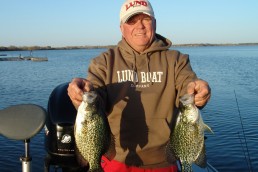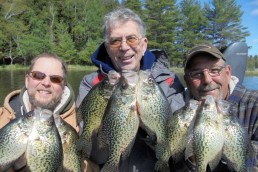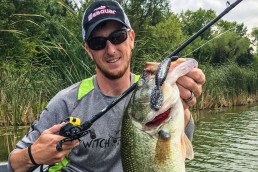Countdown to Early-summer Suspended Crappies
SHARE THIS POST
Believe it or not, crappies are fairly predictable and easy to catch throughout the summer months if you understand their behavior.
After spawning, crappies abandon the extreme shallows. As they regroup and school in early summer, they typically relate to the deep outer weed line in natural lakes, or to flooded standing timber in reservoirs.
Water temps in the high 60s and low 70s are a good indicator that crappies are beginning to set up and school along primary drop-offs to modestly deep basins. Not 70- to 80-foot basins, mind you. More like 30 to 40 is pretty much ideal in many waters.
Schools in the shallows
At the leading edge of this schooling behavior, pods of crappies will be spread across the outer edges of flats, often at the 5- to 10-foot depth level. If cover is present in the form of weeds or wood, expect them to lay low amidst the cover during the day, then rise nearer the surface as the sun drops toward the tree line. Here, they feed on emerging insects and schools of tiny fry swimming just beneath the surface.
Weeds are sparse this early in the summer. They seldom extend to the surface, making it easy to fish small lures above them without snagging. It’s a perfect time to cast and retrieve 1/16-ounce jigs or jig spinners, micro crankbaits, or streamer flies above the cover as active fish rise to prowl and bite about a half hour before sunset, with the activity often extending after dark.
As the weeks go by, schools of crappies become more massive, with the activity shifting more toward the outer edges of the deepest weeds or flooded wood. Fish may still lie beneath the cover during the day, largely inactive, yet then fire off like clockwork as the sun dips toward the horizon. Now, the best bite occurs over the tops of the outer, deeper weeds, along the deep weed line, or a cast-length or so out over the adjacent open water, becoming the focal point for fish activity through mid-summer.
Suspended summer behavior
In natural lakes, the depth of the outside weed line is a good indicator of how deep crappies may suspend adjacent to the weed line—usually somewhere from 6 to 8 feet deep in darker lakes, down to 15 or 18 feet in clear waters.
The easiest way to catch suspended crappies is to cast and swim a 1/16- or 1/32-ounce jig at or slightly above their level. Tiny, 1 ½- to 2-inch, plastic grubs, tubes, puddle jumpers or pre-tied marabou or hair jigs excel for slow, tantalizing sink rates and gentle swimming actions. Mostly, they’re fairly subtle in action. More aggressive and active bodies, like boottails and paddletails, may work as well—particularly when the fish are active.
Are you enjoying this post?
You can be among the first to get the latest info on where to go, what to use and how to use it!
Catching colors
Light colors like white, yellow, light green and such best imitate small minnows that crappies feed on near the surface. Browns or blacks are better insect imitations and may come into play when jigging near bottom. Pink is a killer color, especially around sunset. I’m not sure why and don’t care. I only know that it works wonders during low-light conditions.
Tackle and technique
Using medium-light spinning tackle and 4-pound-test monofilament line, cast parallel to the outside weed edge, letting the lure sink, “one thousand, two thousand, three thousand, etc.,” before reeling it slowly back to the boat. Tiny jigs usually sink about a foot per second, allowing you to target a fairly precise depth. Keep your retrieves slow and steady. Exaggerated lure action usually equals fewer bites.
Use your electric trolling motor to probe slowly along the outer weed edge or timberline, trying different casting angles and depths. Cast parallel to and just outside the deep weed edge, letting your jig sink to 10 feet, before reeling it back in, holding your rod tip slightly above horizontal. On your next cast, pitch your jig slightly up into the weeds, let it descend 3 to 6 feet, and then tick the weed tops during your retrieve. Next cast, aim your jig out over the adjacent deeper, open water, patiently allowing it to sink 12 or 15 feet before retrieval, straining different depths.
One bite leads to another
Repeat the process until you get your first bite—probably a faint bump or a slightly heavy feeling. Your line might jump a little where it enters the water. Set the hook—it’s party time! Crappies almost always school heavily. Once you find the first fish and establish the magic depth, it’s game on. You’ll likely be catching a bunch in quick succession.
Suspended crappies are often visible on your electronics, allowing you to target prime depths of activity. You want to skirt your jig, smoothly and subtly, just above their heads–never below them where they can’t see the lure. The more active they are, the more they will rise to the occasion.
If you don’t know how deep the activity is, just follow along the outer weedline or timberline, casting alternately above the cover, parallel to the edge, and out over the deeper adjacent water. Experiment with the depth of your retrieve: 6 feet, 8, 10 feet, 12 feet or more, until you get bites. Once you do, you’ve located the fish, established their depth, and have ‘em cornered. Enjoy–because you’ll probably catch a bunch.
Corners and turns along outer weed lines, stands of healthy weed growth, flooded timber with lots of branches—something distinctive—often causes crappies to linger in key spots. Steep inside corners at the base of a point, combined with cover, are among the best spots to consistently attract them. The rest of the time, they may slowly patrol back and forth along the drop-off edge, requiring you to search for them, or to recontact moving schools.
Sure, you could slip bobber a minnow in similar areas–but it’s a slow tactic for locating fish and establishing the depth of activity. Once you find ‘em, consider a bobber. The rest of the time, cast, swim, sink and adjust your retrieves with a small jig, instantly adjustable to your—and the crappies’—liking.
MWO
SHARE THIS POST
Did you enjoy this post?
You can be among the first to get the latest info on where to go, what to use and how to use it!
Dave Csanda
Dave Csanda has enjoyed 40 years in the fishing communications industry at In-Fisherman, Angling Edge and now, as editor of MidWest Outdoors. He is an inductee of both the Minnesota and National Fresh Water Fishing Halls of Fame.



